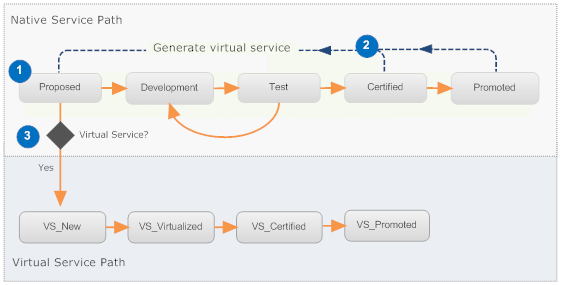Understanding the Lifecycle for Services and Virtual Services
A virtual service is a specialized form of a Service asset type. Because virtual services are actually service objects, a lifecycle model that applies to services applies to virtual services as well. Yet a virtual service and a native service have distinctly different lifecycles. To accommodate this difference, you must create a lifecycle model that defines two separate lifecycle paths.
The following diagram shows a simple lifecycle model that supports both types of services. Note that this lifecycle has a path for native services and a path for virtual services. Policies are used to switch native services and virtual services to the appropriate path.
Note: | To distinguish virtual services from native services (that is, regular SOAP-based Web services, REST services or XML services), CentraSite adds the CentraSite VirtualTypes: Virtual services classifier to a virtual service. This classifier enables you to create design/change-time policies that target virtual services specifically. |
In the following example, the Proposed state is the lifecycle model's initial state. When a native service is created, it enters the Proposed state and from there, it follows the lifecycle path for native services. After a native service is tested and it is ready to be promoted for production, a virtual service is generated for it. The virtual service initially enters the Proposed state when it is created. However, a design/change-time policy immediately switches the virtual service to the lifecycle path for virtual services.
Simple Lifecycle of a Virtual Service on the Creation CentraSite
# | Description |
1 | The Proposed state is the initial state for this lifecycle model. When a native service is created, it enters the Proposed state and follows the lifecycle path for native services. |
2 | A virtual service is generated from the native service when the service is ready to go to production. Generally, this step is performed after the native service has been tested and is considered ready for production or after it has been promoted to the production environment. |
3 | The virtual service enters the lifecycle in the Proposed state, but a policy immediately switches it to the VS_New state, which is the beginning of the lifecycle path for virtual services. This lifecycle path includes states that enable or disable the deployment of the virtual service. Note: | To prevent users from manually switching a native service to the lifecycle path for a virtual service, you can apply a policy to the VS_New state to verify that only service assets classified as CentraSite VirtualTypes: Virtual services enter this path. |
|

